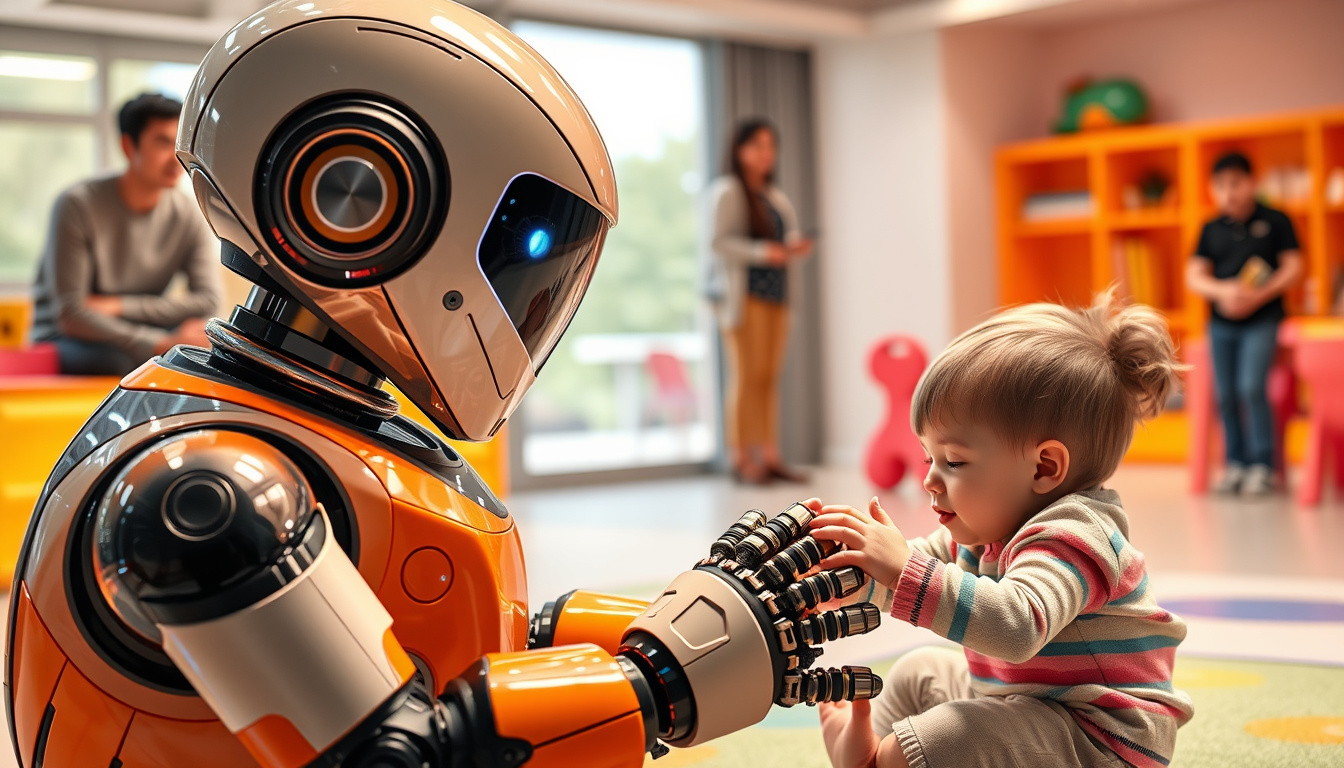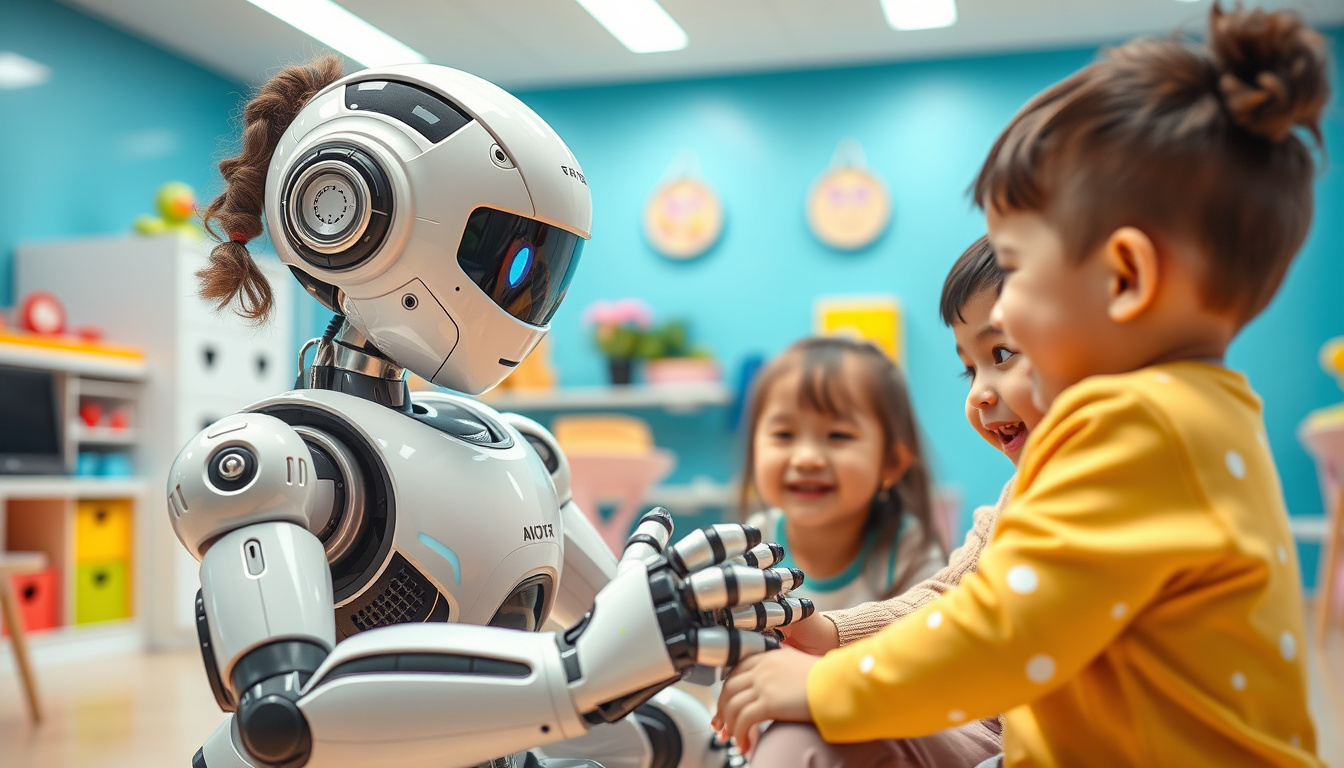Navigating Childcare Robot Regulations: What Parents and Providers Need to Know
As a parent or childcare provider in this fast-paced, technology-driven world, understanding the nuances of childcare robot regulations can feel like deciphering a complex foreign language.
With the rise of robots designed to assist in childcare, from monitoring children to even providing educational content, it's crucial to grasp the current landscape of regulations surrounding these innovations.
So, let’s embark on a journey to demystify the essentials of childcare robot regulations—what you must know to ensure that your little ones are safe while benefiting from some futuristic assistance, and how you can navigate this exciting new frontier of parenting!
Connect and message me on X for Chief of Staff services
Key Takeaways
- Childcare robots are increasingly becoming an integral part of modern parenting support systems.
- Current regulations surrounding childcare robots vary widely, influencing their adoption and functionality.
- Parents should consider safety, efficacy, and regulatory compliance when selecting childcare robots.
- Understanding legal liability is crucial for both parents and providers in ensuring safe robot use.
- Future trends hint at evolving regulations and advancements in childcare robot technology that could reshape parenting.
Understanding the Role of Childcare Robots in Modern Parenting
As a Chief of Staff working closely with tech innovators, I often find myself in the midst of ground-breaking conversations around emerging technologies; one topic that's sparked a great deal of interest—and a fair bit of humor—is the rise of childcare robots.
You see, not long ago during an executive meeting, a CEO quipped that parental anxiety could be alleviated if we simply programmed a robot to offer parenting advice while managing snack time.
If only it were that simple!
However, what's crucial here, and what I find just as amusing as the thought of a robot whispering parenting tips, is the importance of understanding childcare robot regulations.
As businesses navigate the integration of these automated caregivers into our homes and daycares, it's vital for leaders like us to stay informed about legal compliance and safety standards.
Regulations must not only ensure the technology is safe for children, but also address ethical implications around data privacy and parental consent.
Without a thorough understanding of childcare robot regulations, organizations risk not just financial penalties, but also brand reputation.
Addressing these concerns with appropriate protocols during implementation can lead to a successful partnership between parents and robots—creating the next wave of parenting support, minus the eye-rolling from actual humans!
Current Regulations Surrounding Childcare Robots
As the landscape of childcare evolves with technological innovations, the rise of childcare robots has sparked a flurry of interest and some confusion about the current regulations surrounding these robotic caretakers.
In my experience as a Chief of Staff, I've navigated the maze of compliance and policy development for various tech initiatives, and the realm of childcare robot regulations is no different.
These robots are designed to assist in childcare settings, offering everything from basic supervision to engaging educational activities.
However, before you invest in or implement these robots, it's crucial to understand the local and national regulatory frameworks that govern their use.
Regulations may vary significantly by state, and some jurisdictions have begun drafting specific guidelines to ensure the safety and effectiveness of these technologies.
For instance, they might address qualifications for operators, required assessments of robot performance, or even ethical considerations related to child interaction.
Engaging with legal experts and keeping up to date with legislative changes is vital to navigating this ever-evolving milieu.
After all, while a childcare robot can make snack time a breeze, you don’t want to find yourself in a regulatory pickle!
'The advancement of technology is based on making it fit in so that you don't even even even think about it. It's part of your everyday life.' - Bill Gates
Key Considerations for Parents When Choosing Childcare Robots
As a Chief of Staff, I often find myself in the midst of interesting conversations about innovation and technology.
The other day, I was at a dinner party when a colleague excitedly mentioned childcare robots.
He humorously recalled the first time he saw one in action and thought, 'Is this the Jetsons or a scene from a sci-fi horror movie?' With the rapid advancement in AI and robotics, many parents are now considering childcare robots to support their busy family lives.
However, before we can start imagining little robots playing with our children, there’s an important topic that needs addressing: childcare robot regulations.
The regulations surrounding childcare robots are essential for ensuring safety and compliance with child welfare laws.
They govern everything from the technology used in these robots to their interactions with children.
As Chief of Staff, understanding these regulations can be invaluable in assisting executives who are looking to navigate the murky waters of a rapidly evolving market.
Parents should always consider what regulations are in place to protect their children when evaluating such innovative products.
After all, much like running the operations of an organization, ensuring the well-being of future generations is a responsibility that cannot be overlooked.
So, whether you are an executive trying to harness the power of tech in a childcare setting or a parent looking to embrace the future, remember that keeping tabs on childcare robot regulations is not just important—it’s essential!
Connect and message me on X for Chief of Staff services
Legal Liability and Safety Standards in Childcare Robot Use
In the ever-evolving world of early childhood education, the introduction of childcare robots has piqued interest, but it has also brought forth critical concerns regarding legal liability and safety standards.
As we stand on the brink of integrating technology into daycare settings, understanding childcare robot regulations becomes paramount.
For instance, imagine a robot designed to assist children in learning activities.
If this robot accidentally causes a child to fall or experience an allergic reaction to a toy it distributed, the question of legal liability immediately arises.
Who is responsible?
The company that created the robot, the daycare provider, or the developer of the software?
By navigating through the maze of childcare robot regulations, including safety protocols and liability laws, we can ensure that these innovations enhance learning environments safely.
It's essential to stay informed and compliant to not only protect our littlest learners but also the institutions that nurture them.
Best Practices for Providers in Complying with Regulations
As the Chief of Staff, I often find myself in the unique position of straddling the gap between innovative technology and rigorous regulatory landscapes.
Today, I want to share some best practices for providers navigating the burgeoning field of childcare robot regulations.
Picture this: one day, I was knee-deep in a meeting filled with engineers buzzing about our latest childcare robot's features—think interactive learning modules, playful conversations, and even snack distribution capabilities.
Suddenly, a regulatory compliance expert chimed in with a stark reminder: 'While it can teach kids math, it better not teach them to ignore safety regulations!' That moment underscored a crucial lesson—success in the childcare robotics sector requires not just groundbreaking technology but an unwavering commitment to compliance.
Here are the best practices I'd recommend: First, ensure that your product meets all safety standards set forth by governing bodies.
This includes verifying that materials are non-toxic and that the robot's operations are foolproof against common hazards.
Second, maintain clear, ongoing communication with regulatory agencies—think of them not just as enforcers but as partners in your mission to enhance child development.
Next, invest in continuous training for your staff on up-to-date regulations; liken it to keeping your team on the cutting edge of the tech world.
Lastly, embrace a culture of transparency; share your compliance processes with parents and stakeholders to build trust.
By integrating these practices into your operational framework, you’ll not only mitigate the risks associated with childcare robot regulations but also propel your organization to the forefront of the industry.
Let’s turn red tape into a launchpad for innovation!
Frequently Asked Questions
What are childcare robots and how do they assist parents?
Childcare robots are advanced technological devices designed to assist parents in caring for their children.
They can perform various tasks such as monitoring children’s activities, providing educational content, and even helping with daily routines like feeding or diaper changing.
What current regulations exist for childcare robots?
Current regulations surrounding childcare robots vary by region but generally include safety standards, data privacy laws, and guidelines on their usage in childcare settings.
It's essential for parents and providers to stay informed about local laws to ensure compliance.
What should parents consider when choosing a childcare robot?
Parents should consider factors such as the robot's safety features, compliance with regulatory standards, usability, the type of tasks it performs, potential impact on child development, and whether it aligns with their parenting values.
Who is legally liable if a childcare robot malfunctions?
Legal liability in the event of a malfunction often depends on local laws and the circumstances surrounding the incident.
Generally, manufacturers may hold liability for defective products, while parents may bear responsibility for the robot’s use in their home.
What are the best practices for childcare providers in adhering to regulations for robots?
Childcare providers should stay updated on relevant regulations, conduct regular safety evaluations of the robots, ensure adequate training for staff on using technology, and establish clear guidelines for integrating robots into childcare routines.
Connect and Collaborate with Me!
Thank you for exploring the depths of finance and Chief of Staff leadership wisdom with me today.
If the strategies and insights shared here have piqued your interest, or if you're contemplating how these concepts could be tailored to your unique financial goals, I invite you to reach out to me directly on X.com.
📊 Direct Consultation: Discuss your financial plans, get personalized advice, or explore investment opportunities in real-time.
⚡️ Stay Updated: Follow for regular updates, fresh insights, and new strategies as they emerge in the ever-evolving world of finance.
🫱🏼🫲🏿 Networking: Join a community of like-minded individuals where we share knowledge, opportunities, and support each other's financial growth.
🗣️ Ask Questions: If anything in my posts sparks a query or if you seek clarification, X is the perfect platform for a quick, direct conversation.
Whether you're looking to enhance your financial acumen, need bespoke financial planning, or wish to discuss potential collaborations.
To engage with me, simply head over to my profile on X.
.jpg)